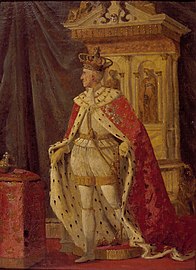
Christian V was King of Denmark and Norway from 1670 until his death in 1699.

Christian VII was King of Denmark and Norway and Duke of Schleswig and Holstein from 1766 until his death in 1808. His motto was "Gloria ex amore patriae".

Christian VI was King of Denmark and Norway from 1730 to 1746. The eldest surviving son of Frederick IV and Louise of Mecklenburg-Güstrow, he is considered one of Denmark-Norway's more anonymous kings, but he was a skilled politician, best known for his authoritarian regime. He was the first king of the Oldenburg dynasty to refrain from entering in any war. During his reign both compulsory confirmation (1736) and a public, nationwide school system (1739) were introduced. His chosen motto was "Deo et populo".

Frederick IV was King of Denmark and Norway from 1699 until his death. Frederick was the son of Christian V of Denmark-Norway and his wife Charlotte Amalie of Hesse-Kassel.

Frederick V was King of Denmark and Norway and Duke of Schleswig-Holstein from 6 August 1746 until his death in 1766. A member of the House of Oldenburg, he was the son of Christian VI of Denmark and Sophie Magdalene of Brandenburg-Kulmbach.

Rosenborg Castle is a renaissance castle located in Copenhagen, Denmark. The castle was originally built as a country summerhouse in 1606 and is an example of Christian IV's many architectural projects. It was built in the Dutch Renaissance style, typical of Danish buildings during this period, and has been expanded several times, finally evolving into its present condition by the year 1624. Architects Bertel Lange and Hans van Steenwinckel the Younger are associated with the structural planning of the castle.

Amalienborg is the official residence for the Danish royal family and is located in Copenhagen. Frederick VIII's palace complex has four identical Classical façades, effectively four palaces, with Rococo interiors, laid around an octagonal courtyard. At the centre is a large equestrian statue of Frederick V. Amalienborg was originally built for four noble families, but after Christiansborg Palace burned in 1794 the royal family bought the palaces and moved in. Over the years various monarchs and their families have lived there, including today's King Frederik X and Queen Mary.

A throne room or throne hall is the room, often rather a hall, in the official residence of the crown, either a palace or a fortified castle, where the throne of a senior figure is set up with elaborate pomp—usually raised, often with steps, and under a canopy, both of which are part of the original notion of the Greek word thronos.

The Danish royal family is the dynastic family of the monarch of Denmark. While some members of the Danish royal family hold the title of Prince(ss) of Denmark, descendants of Margrethe II additionally bear the title Count(ess) of Monpezat. Children of the monarch are accorded the style of His/Her Royal Highness. The King and Queen are styled Majesty.

Danish Crown Regalia are the symbols of the Danish monarchy. They consist of three crowns, a sceptre, globus cruciger, the sword of state and an ampulla . The Danish Royal Regalia are kept in the treasury at Rosenborg Castle. The oldest of these is Christian III's sword of state from 1551. They further include King Christian IV's diamond; pearl- and gold-embroidered saddles; objects carved from ivory and rock-crystal; lapidary pieces of precious stones, and brooches in the form of fantastic animals.
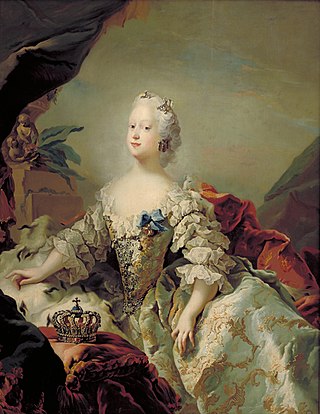
Louise of Great Britain was Queen of Denmark and Norway from 1746 until her death, as the first wife of King Frederick V. She was the youngest surviving daughter of King George II of Great Britain and Caroline of Ansbach.
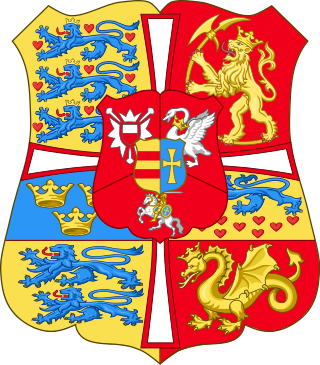
Louise Augusta of Denmark and Norway was the daughter of the Queen of Denmark-Norway, Caroline Matilda of Great Britain. Though officially regarded as the daughter of King Christian VII, it is widely accepted that her biological father was Johann Friedrich Struensee, the king's royal physician and de facto regent of the country at the time of her birth. She was referred to sometimes as "la petite Struensee"; this did not, however, have any effect on her position.

Anne Catherine of Brandenburg was Queen of Denmark and Norway from 1597 to 1612 as the first spouse of King Christian IV of Denmark.

Sophie Magdalene of Brandenburg-Kulmbach was Queen of Denmark and Norway by marriage to King Christian VI of Denmark and Norway.
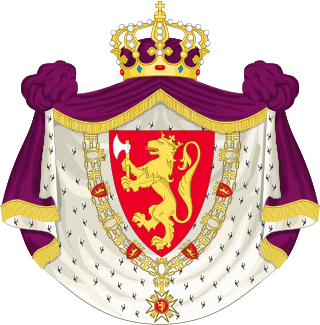
The Norwegian monarch is the head of state of Norway, which is a constitutional and hereditary monarchy with a parliamentary system. The Norwegian monarchy can trace its line back to the reign of Harald Fairhair and the previous petty kingdoms which were united to form Norway; it has been in unions with both Sweden and Denmark for long periods.

The Crown of Christian V of Denmark was the crown used at the coronation of all of Denmark's absolutist kings. While the reign of such monarchs ended in 1849, the crown is still used during a Danish king's castrum doloris, the last time in 1972. Used by the kings from Christian V to Christian VIII. The crown was made by Paul Kurtz in Copenhagen, 1670–1671. It is made of gold with enamel and table-cut stones, weighting in total 2080 g. The jewel also contains 2 garnets and 2 sapphires, of which the largest dates back to Frederick I of Denmark.

The monarchy of Denmark is a constitutional institution and a historic office of the Kingdom of Denmark. The Kingdom includes Denmark proper and the autonomous territories of the Faroe Islands and Greenland. The Kingdom of Denmark was already consolidated in the 8th century, whose rulers are consistently referred to in Frankish sources as "kings". Under the rule of King Gudfred in 804 the Kingdom may have included all the major provinces of medieval Denmark.
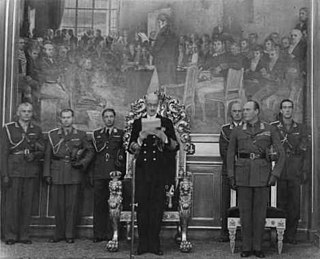
The throne of Norway are the physical representations of the monarchy of Norway. One stands in the building of the Parliament in Oslo, the political capital of Norway, where it is used in a political context. The other stands in Trondheim, the religious capital of Norway, where it was used in a religious context. Lesser known is the throne in the Council Chamber in the Royal Palace. In addition to the thrones, there are two coronation chairs, which are also located in Trondheim. Between 1671 and 1814, the Coronation Chair of Denmark was de facto also Norway's.

Bendix Grodtschilling, also Bendix Grodtschilling the Elder, was a Danish painter and carpenter.

The coronation of the Danish monarch was a religious ceremony in which the accession of the Danish monarch was marked by a coronation ceremony. It was held in various forms from 1170 to 1840, mostly in Lund Cathedral in Lund, St. Mary's Cathedral in Copenhagen and in the chapel of Frederiksborg Palace in Hillerød.



